You’ve probably heard it a hundred times already that in 2022 it is essential to be found on Google. Indeed, the first instinct of potential customers today when looking for a product or a service is to start by doing a search on the web. And even if you know the basics of Google’s criteria for ranking websites, you might not yet know all the intricacies of this ever-changing creature.
SEO, organic positioning or SEO (Search Engine Optimization) refers to the traffic that a web page receives from search engines. As mentioned earlier, it is a major source of traffic for any website.
Mastering SEO is above all understanding the signals that allow search engines to classify the infinite number of websites currently accessible on the internet. And this is important because mastering SEO positioning allows your business to be visible to your target customers, through more traffic to your site and more opportunities to convert prospects into customers. Better SEO positioning also increases brand awareness and helps position you as an expert in your field, giving you a distinctive edge over the competition.
What is SEO positioning ?
SEO positioning represents the set of techniques to improve the position of a website on search engines for a set of keywords.
In other words:
SEO is trying to influence the signals sent to Google so that its website is considered more relevant for Internet users looking for information .
Why SEO positioning is important as a marketing tool ?
More than 30% of traffic goes to the first result on search engines for a given keyword, compared to less than 2% for the last result on the first page. Beyond making it easy for your business to be found on the web, SEO offers many marketing benefits.
The 6 main reasons why SEO positioning is important for your marketing
1. Organic search is most often the main source of website traffic
For most businesses, a large portion of traffic comes from search engines. Search engines like Google are often the gateway for prospects to your website. This is the first step in the sales funnel allowing these visitors to become customers.
In fact, over a trillion people searched Google this year, which is over 52% of the world. It is not uncommon to see over 75% of a website’s traffic coming from search engines like Google.
2. SEO builds trust and credibility
The key to SEO success is having a well-built website that offers a superior user experience that is easily discoverable by search engines thanks to the trust and credibility of the brand.
Establishing a brand’s credibility on the web takes patience, effort and commitment, but it also relies on delivering a quality product or service that allows customers to trust a company. Mark. Of all the factors Google looks at for SEO positioning, website authority is among the most important.
3. SEO has an impact on the buying cycle
Today’s customers are much more educated than ever before. Even for larger purchases, before they’ve even spoken to an advisor or salesperson, people have already done their research on the web, either looking for information on the choices available to them or to compare certain products with each other, or to obtain validation from their peers.
Using SEO to make sure your products and services are seen by your target customers, no matter where they are in their buying process is crucial in setting yourself apart from the competition.
4. SEO is relatively affordable
Of course, everything in life comes at a cost.
But in general, SEO represents a much higher cost benefit than other marketing techniques to promote your business to your target customers.
In fact, SEO positioning should not be viewed as an expense, but rather as an investment. In agencies, we often think of SEO as real estate. Unlike advertising, any investment in SEO will go towards building a solid foundation that will keep you earning for years to come.
5. SEO positioning is quantifiable
While it’s not as easy to calculate the ROI of an organic SEO strategy compared to buying keywords from Google Ads, you can measure almost anything with proper tracking and analytics.
The biggest challenge remains determining what data to consider as Key Performance Indicators (KPI) in order to fully understand the correlation between all the actions taken.
Some tools exist to make your job easier. Google Analytics and Google Search Console, of course, but also other super powerful tools, such as SEMRush, Moz or Mangools, will allow you to directly follow the impacts of your SEO efforts.
6. If you are not on the first page, you are virtually invisible
How many times will you see the second page of results when you google? It is obvious; if you are not on the first page of Google for the keywords you are targeting, your prospects will not be able to find you and you are missing out on a huge source of profit.
A recent study shows that the top three ranking positions in organic search generate over 40% of all clicks.
How to improve your SEO ranking position
1. Target the right keywords:
- Put yourself in your customer’s shoes
Identify your target audience and put yourself in the shoes of a customer when you build your initial keyword list. Ask yourself, “If I wanted to find any of these products or services, what would I type into Google?” You can also consult with other people, such as friends, family members or even current customers to get their opinions on the phrases they would use when researching your products and services.
- Spy on your competitors
Make a list of your main competitors and take the time to take a good look at their websites: the keywords they use, the type of content they present, the media used. There are some great tools out there to help you benchmark your competition in depth, giving you valuable insight into the tactics you can employ to knock them out of the top spot.
SpyFu
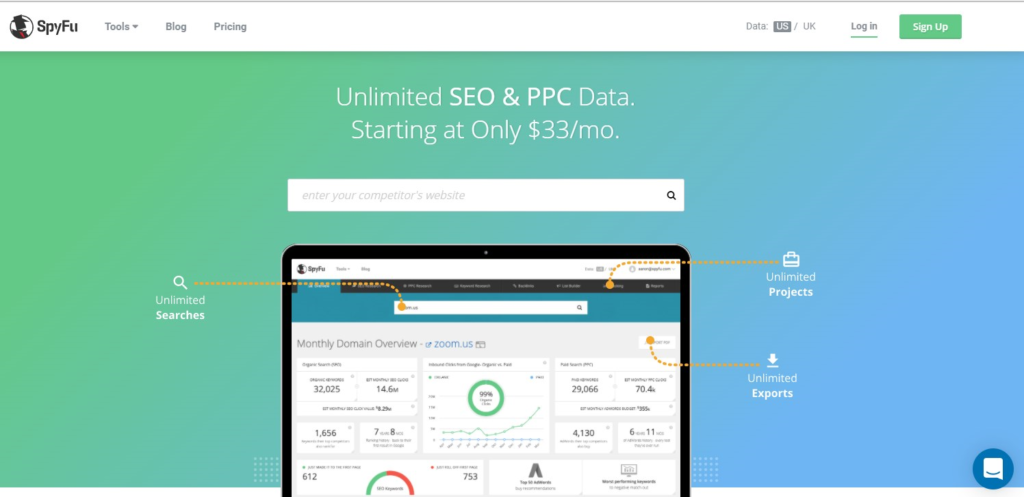
One of the most powerful tools to effectively benchmark your competition on the web.
If you want to see what your competition is doing when it comes to paid and organic search, this is the tool for you.
By simply entering your competitor’s website address into the search bar, you get more data than you ever thought possible.
Here is an overview of the type of data you will be able to collect on your competitors:
- Competition
- Main keywords
- AdWords history
- Rankings history
- Inbound links
You can learn a lot by reviewing each section.
SEMrush
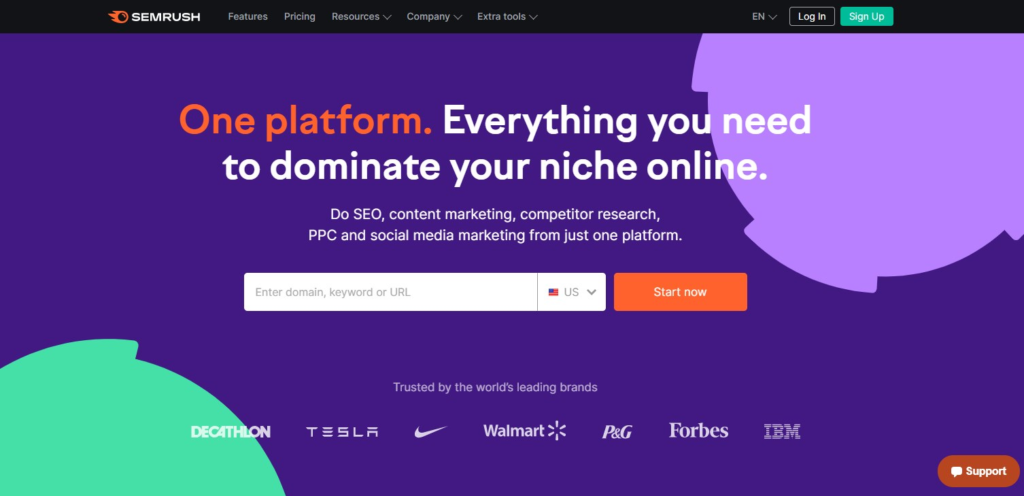
SEMrush has long been recognized as one of the best tools for SEO. In addition to having a section dedicated to the audit of the competition, it is a complete SEO tool offering you practically everything you will need for your SEO positioning.
SEMrush allows you to study your competitors’ traffic, analyze their top performing content and customer engagement with it, allowing you to make decisions based on real data rather than going at it. “By feeling”, SEMrush was also voted Best SEO Tool of 2020.
- Integrate Long Tail keywords into your strategy
Long tail keywords are a combination of at least three key words or phrases. These keyword phrases typically have fewer monthly searches, but they have the potential to get you more targeted traffic. Also, “long tail” keywords are often less competitive and easier to drill.
Again, there is a perfect tool to help you with your search: LongTail Pro
Long Tail Pro
This tool is specialized in the research of “long tail” keywords. From a main keyword, Long Tail pro will offer you up to 800 Long Tail variations. You have the option to add notes to your keyword research, which is great for jotting down longer term ideas and strategies.If you want to discover low competition keywords that will have the greatest impact on your business, Long Tail Pro is one of the best tools to do so.
- Take advantage of keyword research tools
We have already covered a few tools that allow you to do this. In addition to these ( SEMrush , Long Tail Pro and Spyfu ) there are a host of tools specifically designed for keyword research. In general, these tools will allow you to assess the number of searches, competitiveness and analysis of first results on Google for the searched keywords, also giving you suggestions of other keywords that might be relevant to your domain. . You can also use Google's free tools to help you.
KWFinder
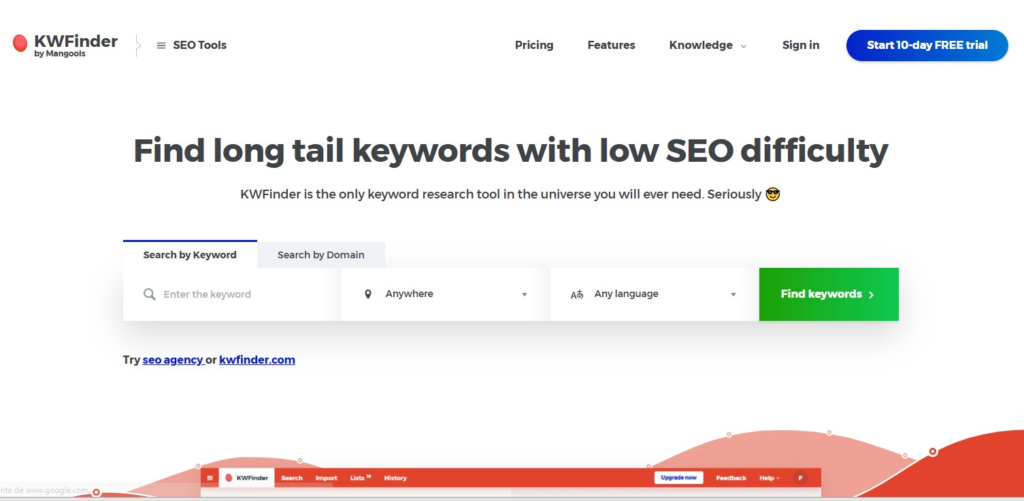
KWFinder is a tool made by Mangools - a developer known for providing the best keyword research tools in all categories. You can use their guide , which is very well done, showing you step by step how to get the most out of this tool.
Keysearch
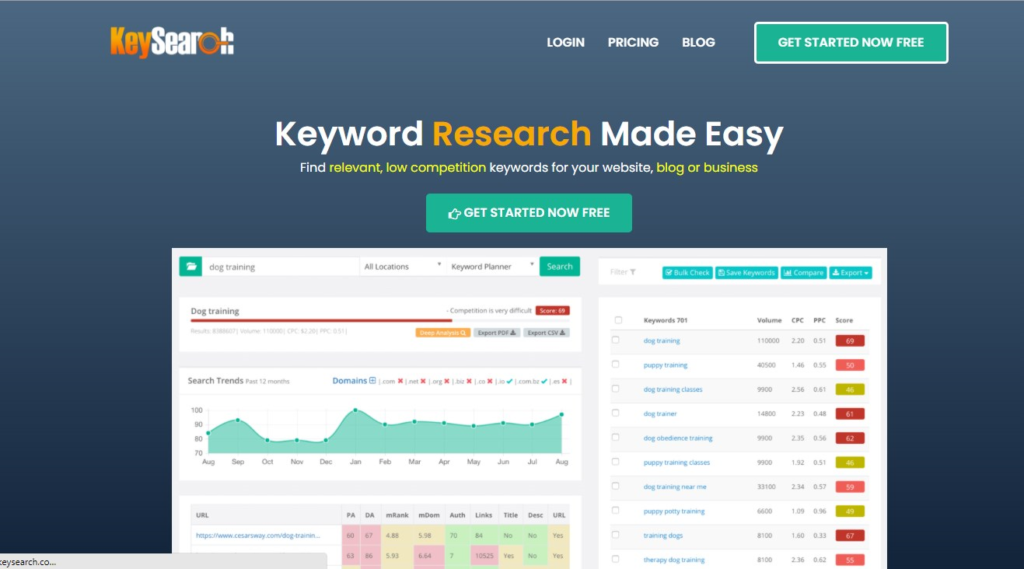
Keysearch is another very well designed tool specifically dedicated to keyword research. Like KWFinder from the Mangools suite, the tool allows you, among other things, to assess the number of searches and the competitiveness of keywords. The biggest advantage of Keysearch is definitely its value for money. It's a great tool for bloggers and small businesses who might not have the budget for a more expensive tool.
SERPStat
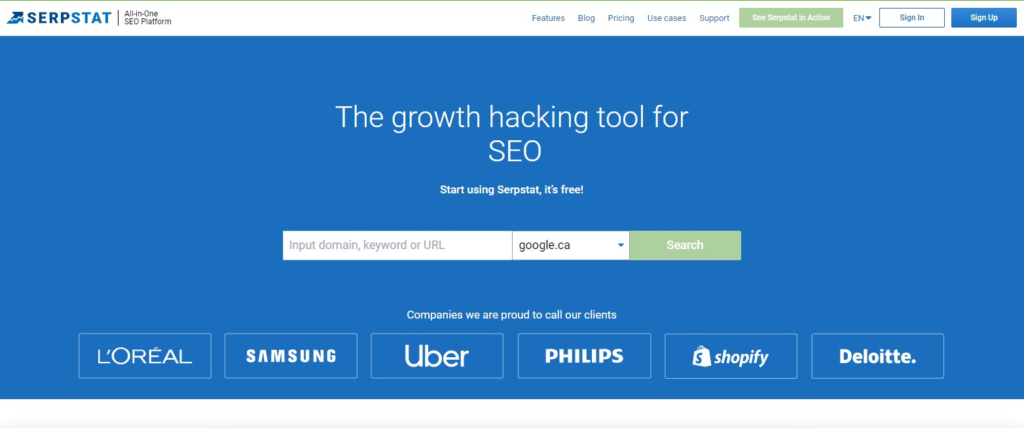
Among the various tools for keyword research, SERPStat stands out for its tool allowing you to see associated research but also filter only the keywords representing questions. These keywords are invaluable for a positioning strategy on Google.
- Analyze your results
After choosing your keywords, don't forget to monitor them and analyze the results. There are often trending keywords or phrases, as well as new keywords that your competition can use.
2. Evaluate your current search ranking
In order to improve your ranking, you need to know where you stand now. This is true even for new sites. Fortunately, there are several tools and resources that can help you.
Use Mangools SERPWatcher to check your site's keyword ranking
If you are targeting specific keywords in the page content, use app.serpwatcher.com to gauge your ranking. Type in your keyword (I used "content marketing" in this example) and the URL of your site. You also have other options like choosing between computer or mobile, and exploring local rankings by city or zip code.
3. Check the speed of your site and fix the technical optimization
Next, it is important to check the speed of the site, as this is a major Google ranking factor.
If your site is slow, you are unlikely to appear on the first page of Google. And you have to remember that there is a direct link between your position on Google and your ability to convert and sell new customers on the web.
According to WebPerformanceToday, Walmart saw a sharp drop in conversions when its page load times fell from one to four seconds.
If that happens, it doesn't matter what your on-page SEO, meta description, or title tags are. The search algorithm will punish you, even if you are a giant like Walmart.
4. Evaluate your backlinks
Backlinks represent other websites that link to your own site. The more sites there are that point to yours, but more importantly, the more these sites will be viewed by Google, the more your Google positioning will benefit. You can of course make sure that your site appears (with a clickable link) on the sites of your business partners, associations, groups, etc. as well as in the most important directories in your industry. You can also spy on links pointing to your competitors using Mangools' SERPWatcher tool. Subscribe to the same professional directories, and you can even reach out to blog writers and influencers to ask them to change their link to point to your article rather than that of your competitor.
5. Optimize your content: where to place SEO keywords
Although Google now understands synonyms, it is still effective to position the targeted keywords in key elements of the site, like titles, url, names and alt tags of images, etc. Be careful with keyword stuffing though. Read your text by putting yourself in the shoes of your potential customers. Is it interesting to read? Do the chosen words sound natural? Is there too much redundancy in the words? If you make sure your text is relevant, well-written, and fluid for readers, it will be relevant for Google too. A text containing Keyword stuffing will be heavy, redundant and unnatural for readers and search engines alike.
6. Popularity and social signals
In general, the more popular a site, the more relevant it will be in the eyes of Google. Several factors are taken into account to evaluate the popularity criterion: the number of visits, time spent on the site, the number of pages viewed per visit, etc. Google will also take into account the number and frequency of mentions on social media, the number of shares, and so on. This is why so many SEO gurus recommend content marketing. Writing relevant, interesting content that readers will want to share is the key to success. If your content is interesting, it will naturally generate visits, people will spend time on the site and share the information with their networks.
Simplify your life
Are you looking for an easy way to optimize your site? Diib is for you!
Diib
Diib improves your SEO positioning through artificial intelligence. With its intuitive interface and dashboard, Diib is easy and pleasant to use. Carefully chosen features are designed to help a website grow. diib aims to provide users with the easiest way to review the most important SEO metrics.
The tool complements any other SEO tool you might have, but it can also work on its own and help you increase your site's performance. Highly effective, this tool provides you with easy to follow suggestions that you can implement on your site in order to generate more traffic for your online business.

